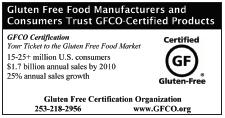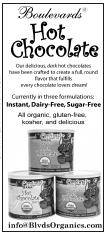Consumers are now more aware than ever of how food affects their overall health. However, for the sector of the population with food sensitivities and special dietary needs, this revelation has been long-lived. With or without a diagnosed condition, Americans are in search of products to address their unique needs. Companies have taken action by launching delicious special diets-related products.
Autumn Bree, marketing and education manager for Manitoba Harvest Hemp Foods and Oils, Winnipeg, Manitoba, Canada, says, “Gluten free has been the biggest trend lately, but the overall public awareness that health is linked directly to the diet has been on the rise and is highlighting all of the other sensitivity issues.”
Many people have concerns about how to transition comfortably into the diet that suits their specific needs. Retailers have the opportunity to help ease their worries and let people know that life with food sensitivities can still be good—and tasty too.
Terminology Isn’t So Intolerable
An important step in helping customers with special dietary needs is to understand the differences between the two types of food sensitivities: allergies and intolerances.
A food allergy is an immune system response. It is caused when the body mistakes a food ingredient as harmful and creates a defense system (antibodies) to fight it. Although a person could have an allergy to any food, the most common food allergies are shellfish, nuts, fish, eggs, peanuts, wheat, soy and milk (1). A typical response to food allergies is anaphylaxis, usually in the form of swelling and the closing of airways. Other reactions can be less apparent, leading to digestive discomfort and possible gastrointestinal damage.
 Food intolerance is a digestive system response rather than an immune system response. It occurs when something within the food irritates a person’s digestive system or when a person is unable to properly digest or break down food. Intolerance to lactose, which is found in milk and other dairy products, is the most common food intolerance (1).
Food intolerance is a digestive system response rather than an immune system response. It occurs when something within the food irritates a person’s digestive system or when a person is unable to properly digest or break down food. Intolerance to lactose, which is found in milk and other dairy products, is the most common food intolerance (1).
Some natural remedies, such as one called Histame from Naturally Vitamins, may help those with certain food intolerances by decreasing histamine levels that cause food intolerance by replenishing the body’s digestive enzyme diamine oxidase (DAO). DAO, the intestinal tract histamine-degrading enzyme, breaks down ingested histamine, thus helping to lower overall histamine levels (2).
For those with severe sensitivities, changing the diet is the only way to avoid a reaction. “Many consumers who have food allergies have a difficult time finding whole food supplements [and foods] they can tolerate. And yet, many of these consumers need the nutrients most,” say Todd Habermehl, co-founder of Amazing Grass, and Lisa Takagi, a Pacific Northwest representative for the San Francisco, CA-based company. Now, many foods are formulated with this in mind and there are plenty of reputable options available.
 Gluten? Darn Tootin’!
Gluten? Darn Tootin’!
Once diagnosed with a food intolerance or allergy, one wonders, what can I eat? The solution might seem simple enough: don’t eat foods to which you are allergic or intolerant. For example, gluten is a special type of protein commonly found in wheat, rye and barley. Therefore, a person with gluten sensitivity would avoid eating the obvious foods such as bread, cereal or pasta. However, many people are unaware of the astounding number of products that contain gluten such as sauces, seasonings and so on. Retailers should be aware of this, explain it to customers and help them find appropriate products and foods.
Clarifying the issues. Being such a hot topic, it’s best to understand the varying degrees of gluten sensitivities before going on a gluten-hunt throughout your store or shooing away customers with gluten-related questions from store shelves.
Gluten sensitivity is a broad term that includes varying degrees of adverse reactions to gluten. While some people have a gluten intolerance leading to slight or severe reactions, a portion of people will test positive for Celiac disease, an autoimmune disorder.
|
Diet and Behavior
|
According to MayoClinic.com, Celiac disease results in damage to villi, tiny hair-like projections in the small intestines, from an autoimmune response to gluten. Villi absorb vitamins, minerals and other nutrients from food, but without them, the inner surface of the small intestine becomes less like a plush carpet and more like a tile floor, unable to absorb nutrients for health and growth. Instead, nutrients such as fat, protein, vitamins and minerals are eliminated in stool. Many people with the disease have intermittent diarrhea, abdominal pain and bloating, but sometimes people with Celiac disease may have no gastrointestinal symptoms at all.
In addition, Keith Berkowitz, MD, who works with Aunt Gussie’s All Natural Cookies and Crackers, Garfield, NJ, says, “There is a growing number of individuals without Celiac disease who are unable to digest gluten properly. In some cases, individuals with irritable bowel syndrome feel better when they avoid products with gluten.”
Cynthia Kupper, RD, executive director of the Gluten Intolerance Group of North America, Auburn, WA, adds, “Some, but not all, persons with multiple sclerosis, autism spectrum disorder, autoimmune skin diseases, chronic fatigue or pain syndromes, gluten ataxia or headaches may respond favorably to the removal of gluten from the diet.”
Who is affected? The estimated number of people suffering from some form of gluten intolerance is as varied as levels of sensitivity to the protein, while some might not even know they have it. A frequently referenced study published in Archives of Internal Medicine, claims one in every 133 people may have Celiac disease (4). The study screened more than 13,000 people in 32 states. “We now believe that more than 1.5 million Americans suffer from Celiac disease, making it twice as common as Crohn’s disease, ulcerative colitis and cystic fibrosis combined,” says Alessio Fasano, MD, the study’s lead researcher and professor at the University of Maryland School of Medicine.
Others believe that the numbers are blown out of proportion and have affected the industry inappropriately. Says Don Stinchcomb, president of Purity Foods, Okemos, MI, “Much of what we are seeing about Celiac has taken a number that Dr. Fasano threw out, unchallenged, while addressing the FDA regarding gluten-free labeling. That one in 133 number has been accepted as fact, but in his presentation it was really an optimistic approximation.”
Stinchcomb says it should not be assumed that all intolerances and reactions can be attributed to gluten and that all products with the “contains wheat” label should not be grouped as having the same reaction-inducing ingredient.
According to www.purityfoods.com, “As of January 1, 2006, the FDA is classifying spelt in the wheat family. To follow this new ruling, all products are going to have the word ‘wheat’ on the package even though they don’t contain any. Every product we carry is made from 100% pure spelt.” Stinchcomb notes that certain types of grains, such as spelt, may not pose such problems and can function as a wheat replacer. “Spelt also works fine with people with severe digestive problems such as irritable bowel [syndrome],” he says.
Also, it should be noted that some products are surprisingly gluten free, such as Amazing Grass’ line of green food products. The wheat and barley grass within the products are harvested at the proper time, say Hebermehl and Takagi—before the gluten forms.
Regarding different products and ingredients, Stinchcomb asks the question: “Does it work for all people in all cases? Does anything? Man made or natural?” Consumers should be encouraged to safely try out products to see what works for their body types and their particular issues.
Taste, anyone? Many people become upset and worried that gluten-free means favorite-food free. This is not the case, as more manufacturers (even mainstream) are creating ways for people to enjoy their favorite foods sans gluten.
Says Stephanie Robbins, director of marketing for Pamela’s Products, Ukiah, CA, “With Pamela’s Baking and Pancake Mix and Pamela’s Gluten-Free Bread Mix, people can make just about anything including ravioli, breaded fish and chicken, corn dogs, pizza and so much more that once they take the feeling of deprivation out, they find they are really feeling better. We also provide a truly decadent line of dessert mixes and cookies. There is no reason for anyone to miss out on their favorite foods just because they’re eating gluten free.”
 Indeed, dessert seems to be a category that garners a lot of concern from consumers going gluten free. Laura Kuykendall, senior marketing manager for Glutino, Laval, Quebec, Canada, says, “We think that people who follow a gluten-free diet, no matter the reason, should know that there are plenty of options available to them. Glutino is excited to launch its new line of Glutino Dream Cookies. The new gluten-free, wheat-free and kosher cookies are a great choice for a gluten-free snack or dessert.”
Indeed, dessert seems to be a category that garners a lot of concern from consumers going gluten free. Laura Kuykendall, senior marketing manager for Glutino, Laval, Quebec, Canada, says, “We think that people who follow a gluten-free diet, no matter the reason, should know that there are plenty of options available to them. Glutino is excited to launch its new line of Glutino Dream Cookies. The new gluten-free, wheat-free and kosher cookies are a great choice for a gluten-free snack or dessert.”
Hillside Candy of Hillside, NJ recognizes that those with sensitive diets also need a treat. The company offers the GoLightly sugar-free candy line and the GoNaturally organic hard candy line.
Got Milk (Alternatives)?
Other common food sensitivities are related to milk and dairy products. Lactose intolerance is the most well known, but is often confused with a milk allergy.
Lactose intolerance is the inability or insufficient ability to digest lactose, a sugar found in milk and milk products. This is caused by a deficiency of the enzyme lactase, which is produced by the cells lining the small intestine. Lactose is typically associated with milk alone, but many prepared foods may also contain it and people with a very low tolerance should be aware that some breads, powdered supplements, salad dressings, margarine, milk by-products and some cereals may also contain it. Also, it has been estimated that 20% of prescription drugs and about 6% of OTC medicines contain lactose (5).
On the other hand, people who are allergic to cow’s milk may react to one or more of the proteins of which it is made: casein (the solid parts, or curd, in milk) or whey (the watery part of milk). The immune system identifies certain milk proteins as harmful, triggering the production of immunoglobulin E antibodies to neutralize the protein (allergen), which can trigger symptoms ranging from coughing, wheezing and anaphylactic shock, to digestive problems. Milk allergies and lactose-intolerant conditions are typically addressed by removing some, or all, dairy products from the diet.
And, fortunately, our industry offers many dairy-free foods with fantastic nutritional profiles. Common non-dairy milk alternatives are soymilk, rice milk or almond milk. Also, says Bree of Manitoba Harvest, many conventional cows are fed a diet that can lead to an unbalanced ratio of omega-3 to omega-6 essential fatty acids. Hempmilk can be a way to address this and a great option for those with soy or nut sensitivities. Manitoba Harvest’s Hemp Bliss provides a balanced ratio of omegas and five grams of protein in a variety of flavors including original, chocolate, vanilla and unsweetened original. Hempmilk is also a good alternative for people with both soy and milk sensitivities.
Hans Fastre, CEO of Portland, OR-based Living Harvest, says, “As a source of important live enzymes, vitamins, minerals, antioxidants and phytonutrients, hemp seeds facilitate the maintenance and improvement of health. Hemp is soy, gluten, dairy and cholesterol free.”
In addition to hempmilk in five flavors, culinary oil and protein powder, the company recently introduced their Tempt line of frozen desserts made from hempmilk. This ensures that those concerned about dairy can still have the ice cream they crave!
Low Glycemic and Low Carb Are High in Popularity
Not all special diets are related to allergies or intolerances. Weight and blood sugar issues are other major reasons for people to choose one other type of specialized diet—low-carb/low-GI. In a Harvard study assessing 12 dietary, lifestyle and metabolic risk factors as causes of preventable death, high blood glucose levels ranked fifth as the most deadly killer after tobacco, high blood pressure, overweight/obesity and physical inactivity, (6).
 To understand these diets, let’s quickly review carbohydrates. In basic terms, carbohydrates are sugars. Simple carbohydrates (monosaccharides and disaccharides) are water-soluble, easy to digest and are quickly absorbed into the bloodstream via the small intestine. This can be problematic, as they can cause a spike in blood sugar leading to a variety of problems. Complex carbohydrates (polysaccharides) are long chains of single sugar units. It has been assumed for some time that all complex carbohydrates are more slowly digested, leading to more stable blood sugar. However, research indicates that the specific configuration of the sugar molecules in different foods is what dictates their absorption rate. A low-carb diet will seek to lower or remove all carbs from the diet. A low-glycemic diet is similar in that it addresses carb intake, but functions slightly differently by focusing on which specific carbs affect blood sugar levels.
To understand these diets, let’s quickly review carbohydrates. In basic terms, carbohydrates are sugars. Simple carbohydrates (monosaccharides and disaccharides) are water-soluble, easy to digest and are quickly absorbed into the bloodstream via the small intestine. This can be problematic, as they can cause a spike in blood sugar leading to a variety of problems. Complex carbohydrates (polysaccharides) are long chains of single sugar units. It has been assumed for some time that all complex carbohydrates are more slowly digested, leading to more stable blood sugar. However, research indicates that the specific configuration of the sugar molecules in different foods is what dictates their absorption rate. A low-carb diet will seek to lower or remove all carbs from the diet. A low-glycemic diet is similar in that it addresses carb intake, but functions slightly differently by focusing on which specific carbs affect blood sugar levels.
“In brief, the glycemic index is a ranking system that measures how much a food raises blood sugar levels,” says Katharine Schuler, director of marketing communications for U.S. Mills, LLC, Needham, MA. A low-glycemic food will not promote rapid spikes in blood sugar and insulin response and does not stimulate fat-storing enzymes, she continues. “Low-glycemic foods tend to be less processed, higher in fiber and contain more nutrients. Many complex carbohydrates, like whole grains, fruits and beans, are often low glycemic, but not all are. While many people managing diabetes rely on the glycemic index to manage their blood glucose, many health professionals believe that, since low-glycemic foods are metabolized more slowly, you are less likely to have the spikes in blood sugars that often cause you to feel hungry sooner. Therefore, following a low-glycemic diet might help some people control their hunger to assist in losing and/or managing weight.”
U.S. Mills offers certified low-glycemic Uncle Sam Cereal with 10 grams of fiber and less than one gram of sugar per serving, plus omega-3s from flaxseed. The company also offers its line of Erewhon cereals, which are dairy free and many of them are gluten free as well.
Diabetics aren’t the only customers who can benefit from low-glycemic and low-carb foods. “Since low-glycemic foods often provide additional nutritional benefits, the best way [for retailers] to communicate the benefits of low-glycemic products to non-diabetic customers is to explain to them what they are getting instead of explaining about what they have to go without,” says Bree.
In addition, says Berkowitz, “There is a huge growth in individuals with insulin resistance who may not have diabetes. These include many individuals who are overweight (especially abdominal fat), with hormonal imbalances (such as polycystic ovarian syndrome) and/or are pre-diabetic. The American Diabetic Association estimates that 57 million Americans are pre-diabetic. All these disorders benefit from carbohydrate restriction.”
Jennifer McGhee, vice president of marketing for Atkins Nutritionals, Inc., Denver, CO, agrees: “The benefits of low-glycemic/low-carb products extend to anyone truly interested in improving their health, reducing their weight, embarking on an anti-aging program, increasing energy, balancing hormones and eliminating inflammatory conditions.” She continues, “The Atkins diet has evolved to include a wide variety of foods that can be used to create a healthy, sustainable lifestyle, rather than a quick-fix diet.” In addition to its bars and shakes, Atkins recently launched two new cuisine products: low-carb All Purpose Baking Mix and Lower-Carb Penne Pasta.
McGhee notes three key benefits to a low-carb/low-glycemic diet:
- Weight loss, because when fewer carbs are eaten, especially white flour and sugar, the body will begin to burn fat as its primary fuel source.
- Sustained weight management by “turning your body into a fat-burning machine” and “supercharged metabolism.”
- Increased, steady energy levels and mood by avoiding highly processed carbohydrates such as refined breads, cereals and pastries. Eating foods low in sugar will help to avoid mood swings associated with rising and falling blood sugar and insulin levels.
 On the weight-loss front, people who followed a low-carbohydrate, high-protein diet lost more weight than people on a low-fat, low-cholesterol, low-calorie diet during a six-month comparison study referenced by Sherrill Selman, naturopathic doctor and author, and Keith Kohler, director of international sales for Core Naturals, Lake Mary, FL. The company offers Salba, a low-carbohydrate seed grain with five grams of fiber in just two tablespoons. It is available as whole seeds, ground seeds, as cold-pressed seed oil (liquid or gelcaps) and in whole foods bars.
On the weight-loss front, people who followed a low-carbohydrate, high-protein diet lost more weight than people on a low-fat, low-cholesterol, low-calorie diet during a six-month comparison study referenced by Sherrill Selman, naturopathic doctor and author, and Keith Kohler, director of international sales for Core Naturals, Lake Mary, FL. The company offers Salba, a low-carbohydrate seed grain with five grams of fiber in just two tablespoons. It is available as whole seeds, ground seeds, as cold-pressed seed oil (liquid or gelcaps) and in whole foods bars.
Making it Work
Many sensitive diet issues go hand in hand, creating a dilemma for many manufacturers and retailers. For example, “Most gluten-free foods are not low glycemic or low carb. In fact, the starches used in gluten-free food production are generally towards the higher values for the glycemic index,” says Jerry Bigam, chairman and CEO of Kinnikinnick Foods, Inc., Edmonton, Alberta, Canada. He says the company has recognized this dilemma for years and continues to work with formulations to lower the GI of their products using fiber, protein and ingredients such as quinoa and buckwheat. The company offers a full line of sensitive diet products that are gluten free, wheat free, dairy free, casein free, nut free and trans-fat free with no preservatives or artificial flavors and colors.
Similarly, Berkowitz says Aunt Gussie’s and B to B Functional Foods are working together to produce a line of products that will include muffins, cookies and bread products that are gluten free, low-carb/low-glycemic and also high in fiber.
 Given the complicated relationships amongst many of these conditions, those with sensitive dietary needs should always consult a healthcare provider. But retailers, too, can also make the experience less confusing. “Food sensitivities are becoming so common that retailers should have a handout (and Web page) prepared that summarizes some of the common foods that might trigger food sensitivity, and that highlights some of the innovative healthy products in their store that are ideal alternatives for people with those food sensitivities,” says Bree. “The best way for retailers to educate customers is to educate themselves about all of the latest information about food sensitivities and to get to know and try various alternatives on the market today. Product demos are important, too. People need to taste, see, smell and understand why the product is a great healthy alternative to what it is replacing.”
Given the complicated relationships amongst many of these conditions, those with sensitive dietary needs should always consult a healthcare provider. But retailers, too, can also make the experience less confusing. “Food sensitivities are becoming so common that retailers should have a handout (and Web page) prepared that summarizes some of the common foods that might trigger food sensitivity, and that highlights some of the innovative healthy products in their store that are ideal alternatives for people with those food sensitivities,” says Bree. “The best way for retailers to educate customers is to educate themselves about all of the latest information about food sensitivities and to get to know and try various alternatives on the market today. Product demos are important, too. People need to taste, see, smell and understand why the product is a great healthy alternative to what it is replacing.”
Retailers should be able to properly identify appropriate products for customers with various types of needs. It can be confusing, but retailers should never guess. Many manufacturers such as Eagan, MN-based French Meadow Bakery have a customer service network, to help retailers and consumers correctly identify certain types of products. If unsure about a product, retailers should take this extra step or advise consumers to do so, as mistakes can be devastating when sensitive diets are concerned. French Meadow Bakery offers all-natural baked goods that are gluten free, lactose free, casein free and peanut free including tortillas, breads, cupcakes, cakes, brownies and cookies. The firm’s Men’s Bread, Hemp Bread and Daily Bread are also certified low glycemic. Beth Naffzinger, marketing manager at the company suggests that retailers “implement label programs within their stores to help consumers navigate through all the claims” and make a more enjoyable shopping experience for everyone. WF
References
- http://my.clevelandclinic.org/disorders/allergies/hic_Problem_Foods_Is_it_an_Allergy_or_Intolerance.aspx, accessed July 27, 2009.
- Histame pamphlet. Naturally Vitamins, www.histame.com.
- www.mayoclinic.com/health/celiac-disease/DS00319, accessed July 27, 2009.
- University of Maryland Press Release, Feb. 10, 2003. www.umm.edu/news/releases/celiac_study.htm, accessed July 27, 2009.
- National Institute of Diabetes and Digestive and Kidney Diseases, National Institutes of Health. http://digestive.niddk.nih.gov/ddiseases/pubs/lactoseintolerance/, accessed July 29, 2009.
- G. Danaei, et al., “The Preventable Causes of Death in the United States: Comparative Risk Assessment of Dietary, Lifestyle, and Metabolic Risk Factors.” PLoS Med 6(4), April 2009.
Published in WholeFoods Magazine, Sept. 2009


 There has been speculation that a gluten/casein-free diet can positively affect behavior in children with ADD and symptoms in the Autism Spectrum. Jerry Bigam, chairman and CEO of Kinnikinnick Foods, Inc., Edmonton, Alberta, Canada, says, “While the science does not yet support direct linkage between diet and behavioral problems, we have thousands of parents who are following the diet and indicating to us that the children (in general) have significant improvements in a variety of behavioral aspects.” Look for more on this in next month’s issue of WholeFoods.
There has been speculation that a gluten/casein-free diet can positively affect behavior in children with ADD and symptoms in the Autism Spectrum. Jerry Bigam, chairman and CEO of Kinnikinnick Foods, Inc., Edmonton, Alberta, Canada, says, “While the science does not yet support direct linkage between diet and behavioral problems, we have thousands of parents who are following the diet and indicating to us that the children (in general) have significant improvements in a variety of behavioral aspects.” Look for more on this in next month’s issue of WholeFoods.







